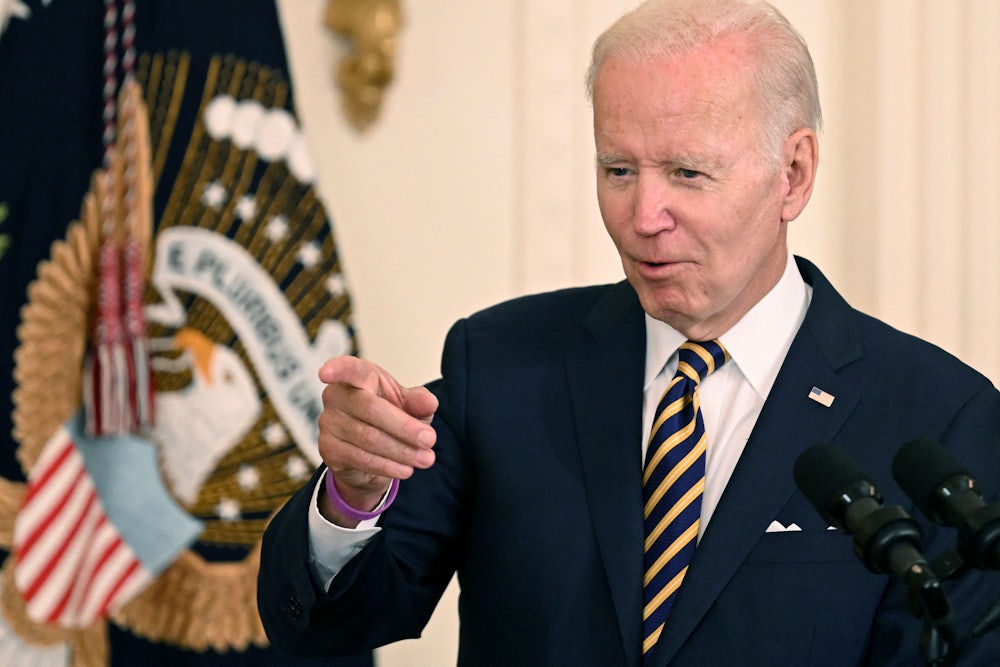For Democrats, 2022 is the ultimate manic-depressive election, except that the extreme moods have come in reverse order.
Two months ago, most Democrats were locked in a fortress of gloom. The widespread expectation was that the 2022 elections would be such a wipeout for the Democrats that American democracy might be wiped out as well. Joe Biden’s approval ratings were beginning to resemble Richard Nixon’s during the depths of Watergate. Gasoline prices were rising so fast that it made older Americans long for the days of the OPEC oil boycotts in the 1970s. The Democrats’ legislative dreams were in tatters, some left-wingers wanted to run Joe Manchin out of the party, and Biden was ridiculed for clinging to an outmoded, nostalgic view of the Senate, which he left in 2009 after 36 years.
These days, in contrast, Democrats are giddy. Kansas voters last week strongly rejected an anti-abortion constitutional amendment. Suddenly, the mood was “Nothing’s the Matter With Kansas” as the vote showed the power of the issue to galvanize Democratic turnout and attract moderates even in the heart of Donald Trump country. Average gasoline prices have now dropped under $4.00 per gallon amid signs that inflation may be easing. Democrats and liberal commentators are doing handstands over the surprise passage of a landmark climate and health care bill (deceptively named the “Inflation Reduction Act”) with Manchin’s strong support.
With the election still nearly three months away, trying to keep your head when everyone else is losing theirs can be a challenge. We live in strange times—and surprise events can still upend expectations either way. But I am thrilled that the Democrats have finally moved off the window ledge and have abandoned their built-in despair about November. A year ago in these pages, I argued, “It is time to treat the supposedly dread Off-Year Curse like it is nothing more than the title of a cheesy horror movie.” Since then, I have consistently cautioned liberals against giving way to an apocalyptic mindset and the defeatist notion that the rest of the decade belongs to Trump and his authoritarian army. But there is also a risk of irrational exuberance. There is little certainty that Biden’s run of legislative achievements will pay political dividends in November. Politics is always a struggle for the future rather than a toast of gratitude for the past.
Humility is the only way to approach an election that is seemingly as idiosyncratic as 2022. Horse race numbers matter but still have their limitations at a time when public polls do not yet have reliable turnout models for November. Instead of overconfident predictions, a more realistic goal at this point is trying to assess the factors that will shape the midterm vote.
The Fundamentals
A prominent Democratic pollster told me, “I worry that we’re on something of a sugar high. We shouldn’t forget that the midterms are about fundamentals. And they are daunting for the Democrats.” He was referring to political basics such as Biden’s still dismal approval rating; the dire reality that only about 20 percent of voters think America is on the right track; and the historical pattern that the president’s party almost always loses House seats and usually Senate seats in off-year elections.
But there is also a counterargument that I find intriguing. Covid-19, in particular, has created a sour mood in this country that shapes attitudes towards everything. Which is why Biden’s approval rating may not be a leading indicator. While the president’s party has lost House seats in all but three off-year elections since the nineteenth century, one of those exceptions was 1998 when the Republicans in their right-wing zeal overreached with their attempt to impeach Bill Clinton. Sound familiar?
For years, the assumption has been that the Democrats have to win the national vote for the House by a healthy majority to overcome built-in GOP advantages due to gerrymandering and the natural clustering of Democrats in urban districts. But Robert Erikson, a political science professor at Columbia, argues that, based on his analysis, this pro-Republican tilt is “almost at the vanishing point.” He cites two major reasons: the overwhelmingly Republican tilt of rural areas creating more wasted GOP votes and the shift of the fast-growing suburbs in the Democratic direction.
The Clarence Thomas Factor
The June 24 Dobbs decision voiding Roe v. Wade would have been a seismic event in any case, but Thomas’s concurring opinion could almost have been written to the specifications of Democratic campaign consultants. Thomas argued that the Court should also overrule precedents that upheld gay marriage and overturned state efforts to ban contraceptives. That meant that the romantic and sexual rights of almost every voter could be threatened if the court maintained its fast march towards the religious right.
Abortion will continue to be in the news through November because Republicans seem unable to take “yes” for an answer. Last week, Indiana enshrined into law a new statewide anti-abortion ban. GOP candidates appear to be deliberately working to turn off swing voters with their anti-abortion zeal. Tudor Dixon, who romped home in the Michigan GOP gubernatorial primary, recently told an interviewer that a proposed abortion ban should also cover the victims of rape and incest.
All this suggests that the Kansas referendum is not an isolated example. A recent Gallup poll found that 8 percent of Americans believe that abortion is the single “most important problem” facing the nation—the highest number in nearly 40 years. And in two recent special elections for the House in Nebraska and Minnesota, Democratic candidates ran better than expected in safe Republican districts.
Trumping Republican Plans
If Mitch McConnell had his way, Trump would devote every waking hour to cheating at golf and grifting. Instead, the Former Guy has made a fetish out of anointing election-denial fanatics in Republican primaries, regardless of their chances in November. In Arizona, the ultimate swing state, Trump-backed candidates such as Senate contender Blake Masters and gubernatorial hopeful Kari Lake swept last week’s primaries. As the results came in, a Republican strategist familiar with the state, said bitterly, “Donald Trump putting himself on the ballot in Arizona is the biggest gift the Democrats could have gotten.”
If politically adept Republicans had their way, the 2022 elections would be a referendum on Biden. Instead, they are fast becoming a measure of Trump’s legacy and the power of the politics of resentment. Come November, Trump’s choice of flawed candidates like New Jersey-resident Mehmet Oz running for the Senate from Pennsylvania and accused-wife-abuser Herschel Walker in Georgia may dash McConnell’s dreams of again becoming majority leader. In political terms for November, Trump’s interventions in GOP primaries may matter more than his legal misadventures.
Green Manchins
It seems like an obvious syllogism: Younger voters care passionately about climate change. Biden, against all odds, has delivered major legislation. Ipso facto, these voters will turnout in record numbers to reward the Democrats in November.
But there are three problems with this logic. These are, for the most part, the same voters who have already been mobilized by the Dobbs decision and the fight to preserve abortion rights. Also, the benefits of the legislation will not be readily apparent since there are still regulations to be written and grants to be administered. Finally, Bernie Sanders grousing about the limitations of the Inflation Reduction Act may temper the enthusiasm of some left-wing Democrats.
Send Them a Message
In an ideal world, strong messaging from the White House would help power the resurgent Democrats to enough victories to hold the Congress. Then you remember that Biden is president and Kamala Harris is vice president. In a speech last week to the Democratic National Committee, Biden used “MAGA” as epithet 11 times, as in “MAGA Republicans” and “MAGA extremism.” Aside from this labored effort to use Trump’s “Make America Great Again” as a political boomerang, Biden offered little more than a laundry list of accomplishments and familiar lines about “the battle for the soul of this nation.” But Biden was eloquent and inspirational compared to his VP, judging from the transcript of Harris’s boilerplate remarks at a recent fundraiser on Martha’s Vineyard.
Messaging by both parties is probably overrated in our saturated media environment. Political ad spending during the 2022 midterms is expected to approach $10 billion. Amid this cacophony of voice-of-doom attack ads, it will be hard for even the cleverest messaging to break through to swing voters and the politically under-motivated. For example, what matters far more than what the Democrats and Republicans say about inflation are the prices that voters themselves will experience in mid-October. If gas is at, say, $3.50 a gallon, GOP scare talk about inflation may not prove to be the motivating factor that it was during the early summer.
Nate Silver’s website, FiveThirtyEight, puts the chances of the Democrats holding the Senate at 60 percent and maintaining their House majority at a surprisingly high 20 percent. But the safest bet of all is that those odds will continue to gyrate in both directions between now and November 8.






